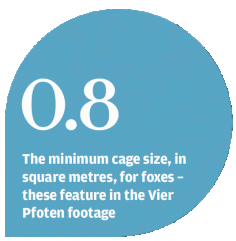‘Politically incorrect’ fur makes a comeback on the catwalk
Two decades after Peta's successful campaign, mink and fox skins are featuring at top fashion shows - to the dismay of animal rights activists
Watch: Controversial Nordic farms flourish on fur comeback
Fur has made a comeback on the world's most important catwalks, fostering a thriving industry in the Nordic region to the dismay of animal rights activists.
In the 1990s, supermodels Claudia Schiffer, Cindy Crawford and Naomi Campbell posed nude for People for the Ethical Treatment of Animals (Peta) under the slogan: "I'd Rather Go Naked Than Wear Fur."

Some professionals think the comeback may be due to the financial crisis.
Fur Europe lobby head Bo Manderup said: "If you're in a situation where the economy is on a downward trend, politicians tend to focus on essentials - how to get economic growth going again, securing jobs.
"The luxury of political correctness may have gone down the drain with the financial crisis."
The luxury of political correctness may have gone down the drain with the financial crisis
In the last 10 years, mink fur production has doubled, reaching 66 million skins last year, according to the Finnish auction house Saga Furs. Despite the rise of Chinese producers, Europe still tops the world ranking, with Denmark in first place.
About 1,400 Danish farmers exported mink fur worth 13 billion kroner (HK$18.5 billion) last year, making it Denmark's leading export to China, where the skins are processed. Subject to the recommendations of the Council of Europe, which requires a minimum cage size - 0.8 square metres for foxes and 0.225 square metres for minks - the industry has created labels that aim to certify the origin and well-being of the animals.
The initiative was labelled a "green-washing" attempt by Austrian animal rights association Vier Pfoten (Four Paws).
The group recently released footage it claimed came from a farm in Finland, the leading European fox fur producer, where the conditions under which it operated were equivalent to "torture".

"This shows that there is no animal-friendly fur farming," Vier Pfoten's wild animals expert Thomas Pietsch said.
In the fast growing Russian and Chinese markets, fur has become a status symbol. As a result, mink prices have risen, attracting new entrepreneurs.
But the mink price rise has boosted production to the point of surplus.
Together with a mild winter in China, the excess caused a 26 per cent price drop in the December auction, said Danish auction house Kopenhagen Fur, the largest in the world.
It said it failed to sell 80 per cent of the merchandise.
